A rapid method for simultaneously quantifying glycerin and nicotine in liquid mixtures used for electronic cigarettes is presented in this article. Using visible near infrared spectroscopy (VIS-NIRS), it is possible to obtain results without preparing samples. This makes VIS-NIRS extremely suitable for rapid quality control.
An electronic cigarette is a device which imitates the act of smoking by heating and vaporizing a solution which contains nicotine, called 'e-liquid'.
Since being introduced to the American market in 2007, the demand for e-cigarettes has risen substantially. Initially, a number of independent manufacturers appeared. However, more recently, interest has piqued in the tobacco industry, and international companies have become the primary distributors of these products.
Generally, the e-liquid solution contains a mixture of propylene glycol, glycerin of vegetable origin, nicotine, and additives acting as flavorings. Usually, the glycerin to propylene glycol ratio is approximately 30:70.
E-cigarette regulation varies between countries, with some issuing complete bans and others having no regulations at all. For instance, the European Union established an upper limit of 20 mg/ml nicotine in e-liquids in 2014. As e-cigarettes are relatively new to the market, it is anticipated that their immense popularity will lead to more stringent regulations being established in years to come.
It is consequently necessary to ascertain a rapid method of determining the content of the ingredients used, in order to guarantee the quality of the product. Visible near-infrared spectroscopy offers a particularly apposite solution, as it allows for the simultaneous determination of numerous quality parameters in under a minute.
Experimental
A customer provided 24 samples, each with different concentrations of aroma, vegetable glycerin, propylene glycol, and nicotine. The nicotine content was between 0-20 mg/ml, while the glycerin content was between 5.00-50.00%.
A Metrohm XDS RapidLiquid Analyzer was used in transmission mode to measure the VIS-NIR spectra. This Analyzer had a spectral range of between 400-2500 nm.
During the measurements, the samples were kept at a constant temperature of 30 degrees centigrade in 8 mm disposable glass vials. The software package Vision Air 2.0 Complete was used for method development and data acquisition (shown in Table 1 and Figure 1).
Table 1: Used equipment and software.
| Equipment |
Metrohm part number |
| NIRS XDS RapidLiquid Analyzer |
2.921.1410 |
| NIRS 8 mm disposable glass vials |
6.7402.000 |
| Vision Air 2.0 Complete |
6.6072.208 |
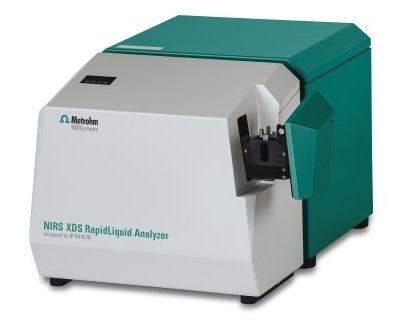
Figure 1: The NIRS XDS RapidLiquid Analyzer was used for spectral data acquisition over the full range from 400 nm to 2500 nm.
During the method development process, insignificant spectral regions were excluded by using 2 derivatives as a pre-treatment and via the selection of specific wavelength ranges. In order to verify the PLS model's performance, internal cross-validation was applied to the data set.
Results
The VIS-NIR spectra of all of the samples analyzed is shown in Figure 2. Already, significant differences between the samples in the wavelength range 1400-1900 nm are visible in the raw spectra. The second derivative spectra of these samples, which was calculated in order to make up for any baseline variations, is displayed in Figure 3.
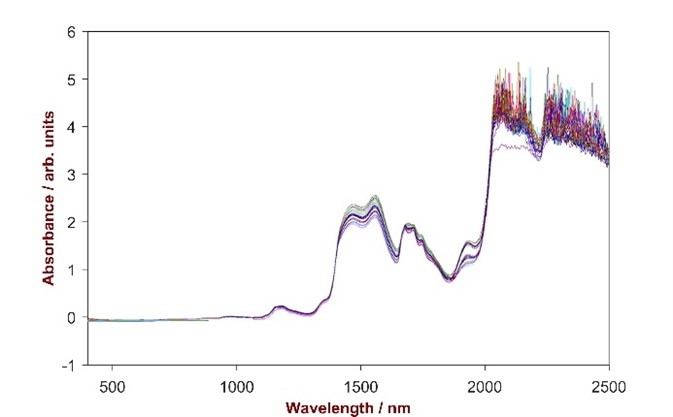
Figure 2: VIS-NIR spectra of 24 e-liquid mixtures.
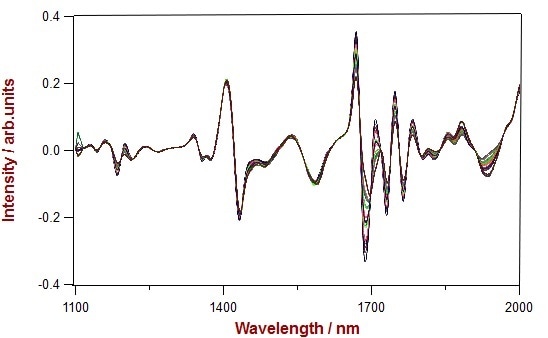
Figure 3: 2nd derivative spectra of 24 e-liquid mixtures in the wavelength region of 1100-2200 nm.
VIS-NIR spectroscopy demonstrates a high correlation between the customer's reference values (shown on the x-axis) and the predicted values (shown on the y-axis), as displayed in the correlation plots in Figures 4 and 5. In addition, low standard errors of cross-validation (SECV/ SEC) and calibration were achieved.
Table 2: Settings and results of the quantitative method development for nicotine.
| . |
. |
| Range |
0.00–20.00 g/ml |
| Regression model |
PLS |
| Number of factors |
3 |
| Wavelength range |
1892–1994 nm |
| Pretreatment |
2nd derivative |
| SEC |
0.58 g/ml |
| SECV |
0.69 g/ml |
| R² |
0.9893 |
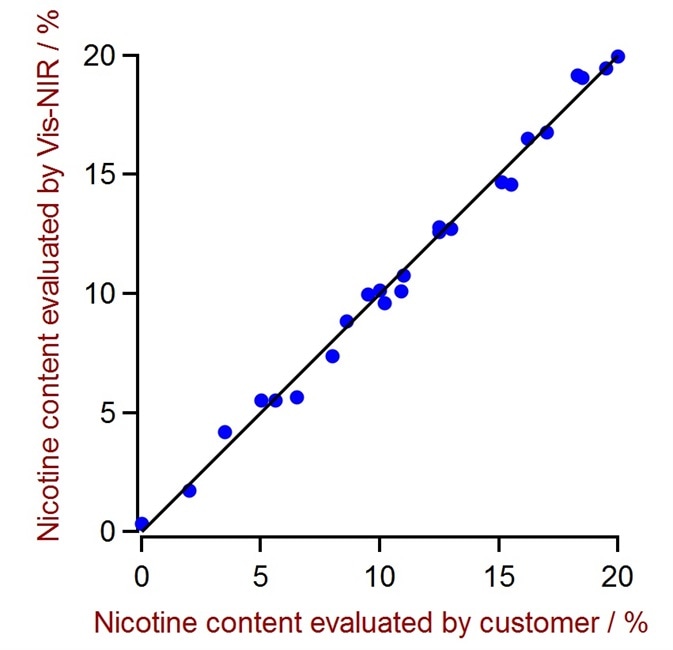
Figure 4: Correlation plot of nicotine content predicted by VIS-NIRS versus reference values.
Table 3: Settings and results of the quantitative method development for glycerin.
| . |
. |
| Range |
5.00–50.00% |
| Regression model |
PLS |
| Number of factors |
3 |
| Wavelength range |
1120–1994 nm |
| Pretreatment |
2nd derivative |
| SEC |
1.53% |
| SECV |
1.63% |
| R² |
0.9877 |
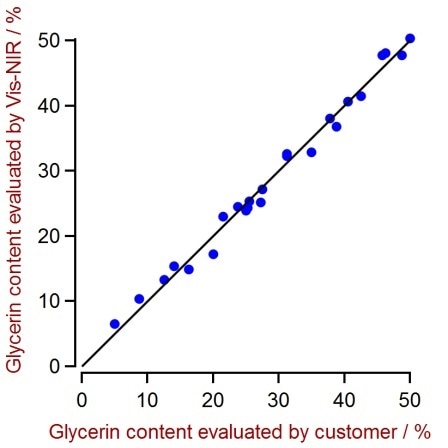
Figure 5: Correlation plot of glycerin content predicted by VIS-NIRS versus reference values. A high correlation is observable.
Summary
The results shown in this article show the feasibility of using VIS-NIR technology for quality control of e-liquids. Used in conjunction with Vision Air 2.0 Complete, the NIRS XDS RapidLiquid Analyzer allows for the simultaneous determination of glycerin and nicotine. Consequently, near infrared spectroscopy seems to be an ideal solution for the rapid analysis of such mixtures without the need for sample preparation.
About Metrohm
At Metrohm is one of the world’s most trusted manufacturers of high-precision instruments for chemical analysis. Metrohm was founded in 1943 by engineer Bertold Suhner in Herisau, Switzerland. Today, Metrohm is represented in 120 countries by subsidiaries and exclusive distributors. The global Metrohm Group also includes the Dutch companies Metrohm Applikon and Metrohm Autolab, manufacturers of online analyzers and instruments for electrochemical research, respectively. Recently, the Metrohm Group was joined by Metrohm Raman, a leading manufacturer of handheld Raman spectrometers.
Metrohm is the global market leader in analytical instruments for titration. Instruments for ion chromatography, voltammetry, conductivity, and stability measurement make the Metrohm portfolio for ion analysis complete. Instruments for Near-infrared and Raman spectroscopy are another, strongly growing segment of the Metrohm portfolio.
Metrohm is a problem solver, both in the laboratory and within the industrial process. To this end, the company offers their customers complete solutions, including dedicated analytical instrumentation as well as comprehensive application know-how. More than 30% of the company’s employees at the Metrohm international headquarters in Herisau work in R&D.
Metrohm has been owned 100% by the non-profit Metrohm Foundation since 1982. The Metrohm Foundation, which does not exert any influence on the company’s business operations, sponsors gifted students in the natural sciences, supports charitable and philanthropic purposes and, above all, ensures the independence of the company.
Sponsored Content Policy: News-Medical.net publishes articles and related content that may be derived from sources where we have existing commercial relationships, provided such content adds value to the core editorial ethos of News-Medical.Net which is to educate and inform site visitors interested in medical research, science, medical devices and treatments.